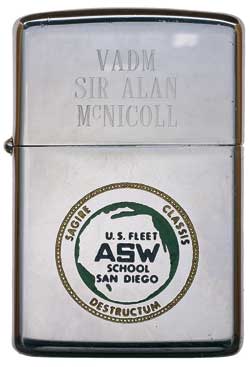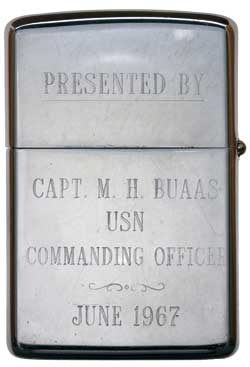Other Properties - Australian Singles
Lot 4950 SESSION 18 (2.30PM FRIDAY 28 JULY) Other Properties - Australian Singles
Estimate $200
Bid at live.noble.com.au
SOLD $540
WAR MEDAL 1939-45. A.W.R.Mc Nicoll. R.A.N. Impressed; also Bradford 'Zippo' cigarette lighter in steel, one side with coloured emblem of a globe with 'U.S.Fleet/ASW/School/San Diego' in the centre and in the band around, 'Sagire Classis Destructum', at the top on the flip-top lid is inscribed, 'VADM/SIR ALAN/McNICOLL', on the other is inscribed, 'PRESENTED BY/CAPT. M.H.BUAAS/USN/COMMANDING OFFICER/JUNE 1967'. Two items, the first with brooch suspender, ribbon damaged, very fine, the second with hairlines, otherwise good very fine.
Sir Alan Wedel Ramsay McNicoll was born on 3 April 1908 at Hawthorn, Melbourne. He attended Scotch College, Melbourne, and, after the family moved to Goulburn, NSW, Scots College, Sydney as a boarder. In 1922 he entered the Royal Australian Naval College at Jervis Bay as a cadet midshipman, graduating in 1926.
From 1930 to 1933, he served in cruisers of the Australian Squadron. He then completed torpedo specialist courses in Britain and in 1935 joined the new cruiser HMAS Sydney as torpedo officer. He was promoted to lieutenant commander in 1938 and the following year posted to Britain as an instructor at the Royal Navy's torpedo school. Shortly after the start of WWII he joined the cruiser HMS Fiji, which was torpedoed on 1 September 1940 and barely made harbour. His next posting was to the submarine depot ship HMS Medway at Alexandria, Egypt, where, beside his torpedo duties, he was frequently involved in rendering enemy ordnance safe. While in this role, he was awarded the George Medal in 1941 for removing inertia pistols from badly corroded torpedoes taken from a captured Italian submarine. This award was presented to him by the King at Buckingham Palace, London on 15/2/1944.
Between 1942-44 McNicoll served in the battleship HMS King George V, in the Admiralty, and on the planning staff for the 1944 D-Day landings in France. He was promoted to commander in 1943 and in 1945 he returned to Australia to become executive officer of the cruiser HMAS Hobart with the British Commonwealth Occupation Force in Japan. Following his promotion to captain in 1949 he successively commanded the 1st Frigate Squadron in HMAS Shoalhaven and the 10th Destroyer Squadron in HMAS Warramunga. In 1954 he was appointed CBE in recognition of his involvement in the British atomic bomb tests at the Montebello Islands off Western Australia in 1952. Two years later while in command of the heavy cruiser HMAS Australia, he rescued a Dutch naval ship in difficulties off Hollandia, Netherlands New Guinea and in recognition of this action he was appointed a Commander of the Order of Orange-Nassau in 1956.
Captain McNicoll attended the Imperial Defence College, London, in 1955 and in 1957 he was promoted to Acting Rear Admiral and appointed head of the Australian joint service staff. He returned to Australia in 1958 as Deputy Secretary (Military), Department of Defence, and Chairman of the Joint Planning Committee and then promoted to the substantive rank of Rear Admiral. In 1960 he was made second naval member of the Naval Board and then was posted as Flag Officer Commanding the Australian Fleet in January 1962.
During Rear Admiral McNicoll's term as fleet commander he successfully organised the acceptance and deployment of new minesweepers, modern anti-submarine warfare ships and helicopters, and afloat support capabilities. In January 1964 he returned to the Naval Board as chief of supply. In the 1965 New Year Honours he was appointed CB and in February McNicoll was promoted to Vice Admiral and appointed Chief of Naval Staff. In the New Year Honours of 1966 he was appointed KBE.
During Vice Admiral McNicoll's tenure the Oberon-class submarines and Adams-class destroyers became successes, a new class of patrol boats was commissioned, the Fleet Air Arm was re-equipped with American aircraft, and the RAN commitment of destroyers, clearance divers and helicopter units to Vietnam enhanced its strategic and tactical development. Another of his legacies is the Australian White Ensign, which replaced that of the Royal Navy in March 1967.
Retiring from the RAN in 1968, McNicoll was appointed Australia's first ambassador to Turkey until his retirement from public life in 1973. He died at Canberra on 11 October 1987 and was cremated with full naval honours.
Estimate / sale price does not include buyer's premium (currently 22% including GST) which is added to hammer price. All bids are executed on the understanding that the Terms & Conditions of sale have been read and accepted. For information on grading and estimates please refer to the Buying at Auction advice.
Quick find
View a lot by number and sale.
Adjacent lots
Lot 4948
AUSTRALIA SENIOR CADETS, Commonwealth Military Competitions, Brigade Competitions Champion Team 1911-12. Engraved naming on reverse ...
Estimate $250
Lot 4949
ANZAC COMMEMORATIVE MEDALLION 1915, issued in 1967, in bronze (50x75mm) (C.1915/3), named to S.J.Hill. In ...
Estimate $300
Lot 4950 This lot
WAR MEDAL 1939-45. A.W.R.Mc Nicoll. R.A.N. Impressed; also Bradford 'Zippo' cigarette lighter in steel, one ...
Estimate $200
Lot 4951
AUSTRALIA, Civilian Service Medal 1939-45, instituted in 1994 for service during WWII by civilians who ...
Estimate $200
Lot 4952
VICTORIAN LOCAL FORCES, c1880s, badge for fifteen years service, in gold (tests as 21ct, 12.5g, ...
Estimate $600

